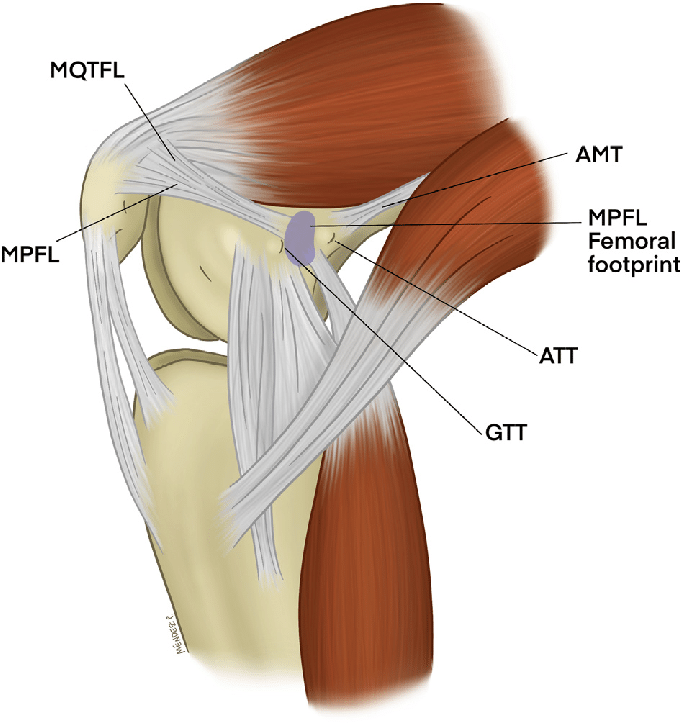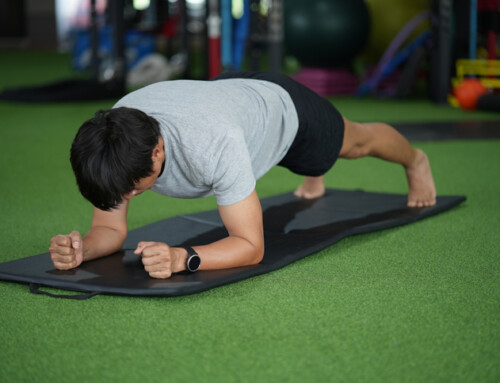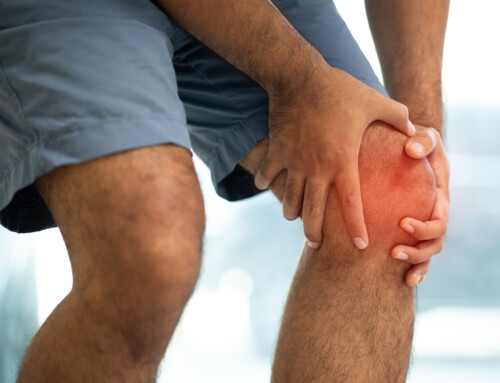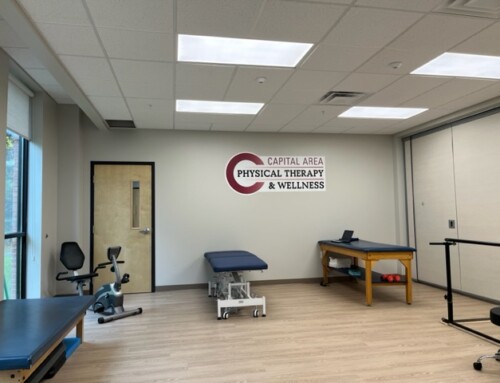by Reiko Jones, SPT

Dynamic–Anatomical Reconstruction of Medial Patellofemoral Ligament in Open Physis – Scientific Figure on ResearchGate. Available from: https://www.researchgate.net/figure/Medial-view-of-a-flexed-knee-is-shown-Anatomy-of-the-MPFL-AMT-adductor-magnus-tendon_fig1_342453941 [accessed 15 Mar, 2022]
What is the MPFL?
The MPFL ligament is a ligament that attaches from the knee cap (patella) to the thigh bone (femur). Its primary purpose is to stabilize the knee, however, it also assists in the kneecap maintaining its position during knee movement when bending and straightening the knee. MPFL injuries often occur with a traumatic kneecap dislocation or partial dislocation (subluxation). If an individual has a loose ligament either from repeated trauma, naturally loose ligaments and/or individual anatomical variations may develop patellar instability, where the kneecap does not track correctly and slips out of the groove.
Clinical presentation of MPFL Injury:
- Knee “giving way” or “buckling” during activity
- “locking”, stiffness or pain with prolonged sitting either with knee straight or bent
- Knee swelling after activity
- Knee pain during movement and tenderness along knee joint
Risk factors for Injury:
- Female
- Young, active individuals
- Vastus medialis oblique (VMO; one of the quadriceps muscles) and hip adductor muscle weakness
- Iliotibial band tightness
- Patella alta (high-riding kneecap)
Physical Therapy Treatment
PT is the standard of care for MPFL injuries and a physical therapist will design a treatment program specific for the individual based on their needs, goals, and return to sport if needed. Some interventions that may be included in PT treatment:
Patient education/ Activity Modification: Including understanding condition and what to expect for recovery, guidance to help return safely to activities with activity modifications to help protect the knee joint as it heals, and providing a home exercise program to enhance recovery
Modalities: Can be utilized to manage pain and swelling and enhance therapeutic exercises for muscle strengthening and range of motion
Range of motion (ROM): Injury to a joint and surgery will limit knee mobility. It is important to restore normal ROM in a timely manner. Exercises to help restore normal mobility will be given.
Muscle strengthening: Strengthening the muscles around the knee, hip and core will help manage forces applied to the knee. Targeted exercises for an individual targeting weak areas will be prescribed.
Manual therapy: Therapist hands-on techniques may be utilized to help decrease pain, enhance joint mobility, ROM, and strength.
Gait Training: Assistive device (e.g. crutches) training if needed and training to help normalize walking and running pattern
Balance/ Proprioception training: Proprioception is the body’s ability to perceive the joint in space, the brain receives info from different areas including proprioception information, and will send signals for muscles to adjust to help maintain balance. The body’s sense of positioning can become abnormal with trauma. Balance and proprioception targeted activities will help individuals increase balance, maintain safety and be able to return to normal activities/sports.
Capital Area Physical Therapy & Wellness physical therapy clinics in the NY Capital Region include Saratoga, Malta and Queensbury NY. Contact us for more information on treatments and techniques to help you decrease pain, improve function, and reach your goals. Call 518-289-5242 today to schedule your evaluation.
References:
1. Physical Therapy Guide to Medial Patellofemoral Ligament Injury. American Physical Therapy Association. Reviewed November 28, 2021. Accessed February 25, 2022. https://www.choosept.com/guide/physical-therapy-guide-medial-patellofemoral-ligament-injury
2. Shubin Stein BE, Strickland SM. Medial Patellofemoral Ligament Reconstruction. Hospital for Special Surgery. June 27, 2016. Accessed February 25, 2022. https://www.hss.edu/conditions_medial-patellofemoral-ligament-reconstruction-mpfl.asp
3. Negrín R, Reyes NO, Iñiguez M, Gaggero N, Sandoval R, Jabes N, Mendez M. Dynamic-Anatomical Reconstruction of Medial Patellofemoral Ligament in Open Physis. Arthrosc Tech. 2020 Jun 25;9(7):e1027-e1032.
4. Vitale TE, Mooney B, Vitale A, Apergis D, Wirth S, Grossman MG. PHYSICAL THERAPY INTERVENTION FOR MEDIAL PATELLOFEMORAL LIGAMENT RECONSTRUCTION AFTER REPEATED LATERAL PATELLAR SUBLUXATION/DISLOCATION. Int J Sports Phys Ther. 2016;11(3):423-435.





